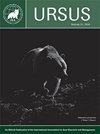2008-2014年楚科奇海东北部北极熊对船只调查的行为反应
IF 0.6
4区 生物学
Q4 ZOOLOGY
引用次数: 0
摘要
摘要:评估人类活动对北极野生动物的影响是当前北极野生动物管理和保护策略的关键问题。随着全球气候变化、航线扩张和北极地区工业发展的增加,北极熊(Ursus maritimus)的生存面临着新的挑战。北极熊对船只存在的行为反应并没有很好的记录。在2008-2014年楚科奇海洋环境研究项目(cesp)期间,通过夏秋两季的船只调查收集了北极熊的发生和行为数据。我们通过距离检查了北极熊的出现和对船只存在的行为反应。在本次研究中,3艘调查船共进行了56,901公里的观测,记录了42组北极熊(50只)。超过一半的群体表现出行为反应(即警惕或逃跑),包括所有有幼崽的母亲群体。北极熊对船只做出反应的平均距离(805±648米)比没有反应的平均距离(2001±1368米)更近。Logistic回归分析显示,反应与距离有关,我们的模型显示,50%的北极熊会表现出行为反应的估计距离为1,645米。我们的研究结果与评估北极船只活动增加的潜在影响有关,并有助于制定有效的北极熊监测和缓解战略。本文章由计算机程序翻译,如有差异,请以英文原文为准。
Polar bear behavioral response to vessel surveys in northeastern Chukchi Sea, 2008–2014
Abstract: Evaluating the impacts of anthropogenic activities on Arctic wildlife is a key issue in current management and conservation strategies. With global climate change, expanding shipping routes, and increasing industrial development in the Arctic, the polar bear (Ursus maritimus) faces new challenges to its survival. Polar bear behavioral response to vessel presence is not well-documented. During the 2008–2014 Chukchi Sea Environmental Studies Program (CSESP), polar bear occurrence and behavioral data were collected during summer–autumn vessel surveys. We examined polar bear occurrence and behavioral response to vessel presence by distance. During this study, 56,901 km of observation effort occurred from 3 survey vessels and 42 groups (50 individuals) of polar bears were recorded. Over half of the groups exhibited a behavioral response (i.e., vigilance or flee) including all groups of mothers with cubs. The mean distance at which bears responded to vessels (805 ± 648 m) was closer than the mean distance at which no response was observed (2,001 ± 1,368 m). Logistic regression analysis revealed that response was associated with distance and our model indicated the estimated distance at which 50% of the polar bears would exhibit a behavioral response to be 1,645 m. Our findings are relevant to assess potential impacts of increasing vessel activity in the Arctic and to assist in the development of effective monitoring and mitigation strategies for polar bears.
求助全文
通过发布文献求助,成功后即可免费获取论文全文。
去求助
来源期刊

Ursus
生物-动物学
CiteScore
2.00
自引率
15.40%
发文量
12
审稿时长
>12 weeks
期刊介绍:
Ursus includes a variety of articles on all aspects of bear management and research worldwide. Original manuscripts are welcome. In addition to manuscripts reporting original research, submissions may be based on thoughtful review and synthesis of previously-reported information, innovative philosophies and opinions, and public policy or legal aspects of wildlife conservation. Notes of general interest are also welcome. Invited manuscripts will be clearly identified, but will still be subject to peer review. All manuscripts must be in English. All manuscripts are peer-reviewed, and subject to rigorous editorial standards.
 求助内容:
求助内容: 应助结果提醒方式:
应助结果提醒方式:


